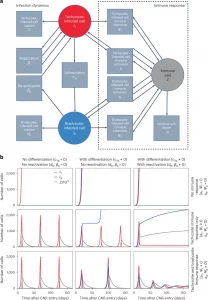Toxoplasma gondii is best known for causing toxoplasmosis, a generally asymptomatic infection in healthy individuals but one that can pose serious risks during pregnancy or in immunocompromised individuals. The parasite is most contracted through undercooked meat or contact with infected cat faeces.
For decades, scientists believed that certain pathogens, once hidden in the brain, could persist undetected by the immune system. A new study flips this assumption on its head. The team shows that the immune system can detect and respond to latent Toxoplasma gondii infections, a discovery with wide-ranging implications for infectious disease research and treatment (Figure 1).

Figure 1: Compartmental modelling of T. gondii infection in the CNS predicts the presence of immune responses to tachyzoites and bradyzoites. a, Petri net representing the infection (left) and immune response (right) dynamics in equations (1)–(3). Circles represent different cell populations: tachyzoite- (IT, red) or bradyzoite-infected (IB, blue) cells and immune cells (Z, grey). Squares represent a particular reaction. Arrows entering a square represent reactants, and those leaving represent products. The two arrows from βT to IT represent a +1 increase in parasite numbers, and similarly, two arrows from αT (αB) to Z represent the ability of tachyzoite (bradyzoite)-infected cells to amplify the immune response. b, Graphical representations of potential outcomes for the numbers of tachyzoite-infected cells (IT, red), bradyzoite-infected cells (IB, blue) and immune cells (Z, grey) after parasite entry into the CNS, based on equations (1)–(3). Columns show different parasite dynamics: no parasite differentiation nor reactivation (cTB = 0 and dB, βB = 0; left column), differentiation but no reactivation (cTB ≠ 0 and dB, βB = 0; middle column), or both differentiation and reactivation (cTB ≠ 0 and dB, βB ≠ 0; right column). Rows show different immune responses: no immune response (aT, ψT = 0 and aB, ψB = 0; top row), immune responses against tachyzoites only (aT, ψT ≠ 0 and aB, ψB = 0; middle row), or immune responses against tachyzoites and bradyzoites (aT, ψT ≠ 0 and aB, ψB ≠ 0; bottom row). When nonzero, the parameters used were S0 = 108, IT (0) = 1, IB(0) = 0, Z(0) = 105, dT = 0.2, dB = 0.01, βT = 1.7, βB = 0.2, cTB = 0.25, aT = 105, aB = 0.2 × 105, µ = 0.1, ψT = 50, ψB = 10.
The study reveals that even during its so-called dormant phase, Toxoplasma gondii, a common brain parasite, remains in the immune system’s crosshairs. This challenges the long-standing belief that once the parasite forms cysts inside neurons, it becomes completely invisible to immune surveillance.
In its latent phase, Toxoplasma forms cysts inside neurons, helping it persist long-term in the host. Until now, these cysts were thought to be a safe haven, essentially invisible to the immune system. But the new study shows that this isn’t the whole story.
Using mouse models, the researchers demonstrated that certain T cells do, in fact, recognise and respond to neurons containing Toxoplasma cysts, helping control the infection. Interestingly, they also found that if the parasite is genetically prevented from forming cysts, the result is even worse: higher parasite loads and greater brain damage.
These findings challenge two long-held assumptions:
- That neurons offer a complete refuge from immune detection
- That forming cysts is the only way the parasite can persist long-term
Even when cyst formation was genetically blocked, the immune system failed to fully eliminate the parasite, suggesting that the chronic phase of infection is far more complex than previously thought.
To validate their experimental findings, the researchers used mathematical modelling to explore the dynamics of cyst formation and immune clearance. The modelling supported the idea that immune pressure actively shapes cyst dynamics over time.
If immune cells can recognize and act on latent infections, then targeting these mechanisms could help treat or even clear infections that have long evaded standard therapies. For diseases like toxoplasmosis and other latent infections of the nervous system, this could mark a turning point in developing curative strategies.
Journal article: Eberhard, J. N., et al., 2025. Immune targeting and host-protective effects of the latent stage of Toxoplasma gondii. Nature Microbiology.
Summary by Stefan Botha










